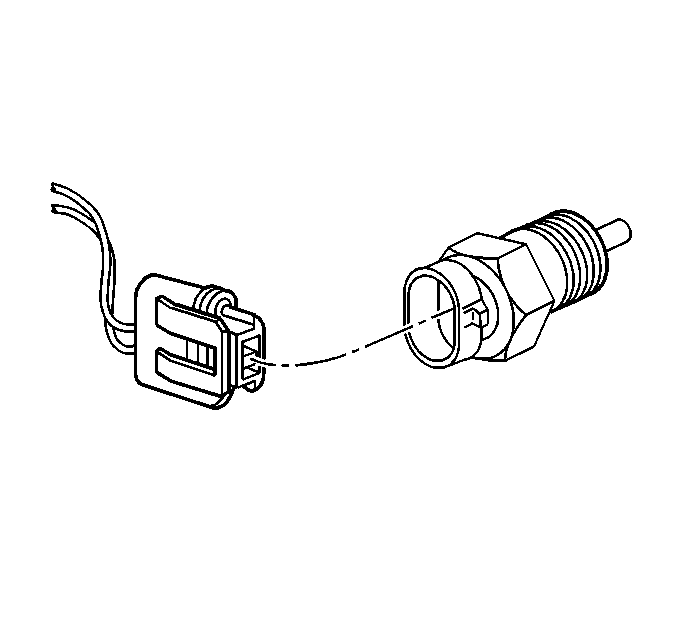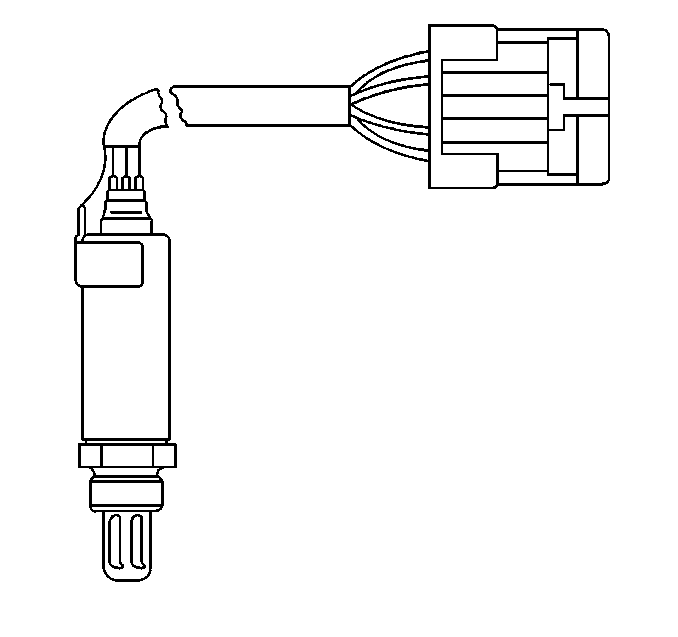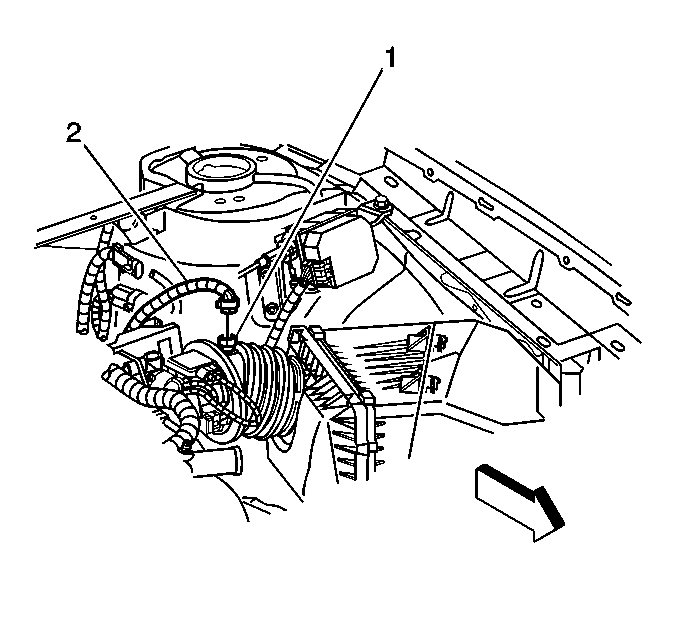3X Reference PCM Input
The powertrain control module (PCM) uses this signal from the ignition control module (ICM) to calculate the engine RPM and the crankshaft position (CKP) at engine speeds of more than 1200 RPM. The PCM also uses the pulses on this circuit to initiate the fuel injector pulses. If the PCM does not receive pulses on this circuit, DTC P1374 sets and the PCM uses the 18X reference signal circuit for fuel control and for ignition control. The engine continues to start and run using the 18X reference signal.
18X Reference PCM Input
The PCM uses this signal from the ICM in order to calculate the engine RPM and the CKP at engine speeds of less than 1200 RPM. The PCM also uses the pulses on this circuit to initiate the fuel injector pulses. If the PCM does not receive pulses on this circuit, DTC P0336 sets and the PCM uses the 3X reference signal circuit for fuel control and for ignition control. The engine continues to start and run using the 3X reference signal.
A/C Refrigerant Pressure Sensor
The A/C refrigerant pressure sensor signal indicates the high-side refrigerant pressure to the PCM. The PCM uses this information to adjust the idle air control (IAC) valve to compensate for the higher engine loads present with high A/C refrigerant pressures, and to control the cooling fans. A fault in the A/C refrigerant pressure sensor signal causes DTC P0530 to set. Refer to HVAC for a complete description.
A/C Request PCM Input
The A/C request signal indicates to the PCM that an A/C mode is selected at the A/C control head. The PCM uses this information to adjust the idle speed before turning ON the A/C clutch. If this signal is not available to the PCM, the A/C compressor will be inoperative.
Crankshaft Position (CKP) Sensor
The CKP sensor provides a signal used by the ICM to calculate the ignition sequence. The ICM also uses the CKP sensor signals to initiate 18X and 3X reference pulses which the PCM uses as reference to calculate RPM and crankshaft position.
Camshaft Position (CMP) Sensor and CAM Signal
The CMP sensor sends a cam signal to the PCM which uses the signal as a sync pulse in order to trigger the injectors in the correct sequence. The CAM signal is passed through the ICM. The signal is filtered and buffered by the ICM, but the signal is not processed in any other way. The PCM uses the CAM signal in order to indicate the position of the #1 piston during the pistons power stroke. This allows the PCM to calculate a true sequential fuel injection (SFI) mode of operation. If the PCM detects an incorrect CAM signal while the engine is running, DTC P0341 is set.
If the CAM signal is lost while the engine is running, the fuel injection system shifts to a calculated SFI mode based upon the last fuel injection pulse, and the engine continues to run. The engine can be restarted and run in the calculated sequential mode as long as the fault is present, with a 1 in 6 chance of the sequence being correct.
Refer to DTC P0341 Camshaft Position (CMP) Sensor Performance for further information.
Electronic Brake and Traction Control Module (EBTCM) / Electronic Brake Control Module (EBCM) - PCM Class 2 Serial Data
The PCM uses the Class 2 serial data line to communicate with various other components and systems within the vehicle. The PCM ensures that communication remains established by monitoring the Class 2 serial data circuit for state of health (SOH) messages from the other devices using the circuit. If the PCM detects a loss of the SOH serial data message from the electronic brake and traction control module (EBTCM), the PCM stores DTC P1602.
The PCM also receives rough road information from the EBTCM on the Class 2 serial data circuit. The PCM uses the rough road information in order to enhance the misfire diagnostic by detecting any crankshaft speed variations caused by driving on rough roads. This allows false misfire information to be rejected. The EBTCM calculates the rough road information by monitoring the ABS wheel speed sensors. If a malfunction occurs which does not allow the EBTCM to transmit the correct rough road information to the PCM while a misfire DTC is requesting the MIL, DTC P1380 sets. If a loss of communications causes the PCM to not receive the rough road information while a misfire DTC is requesting the MIL, DTC P1381 sets.
Under certain conditions, the PCM has the ability to command the EBTCM to shut off the traction control via the Class 2 serial line. The following DTCs cause the traction control to be disabled, an ABS/TCS DTC to set, and the traction OFF lamp to illuminate:
| • | DTC P0101 - Mass Air Flow System Performance |
| • | DTC P0102 - Mass Air Flow Sensor Circuit Low Frequency |
| • | DTC P0103 - Mass Air Flow Sensor Circuit High Frequency |
| • | DTC P0171 - Fuel Trim System Lean |
| • | DTC P0172 - Fuel Trim System Rich |
| • | DTC P0200 - 206 Injector Control Circuit |
| • | DTC P0300 - Engine Misfire Detected |
| • | DTC P0336 - 18x Reference Signal Circuit |
| • | DTC P0341 - Camshaft Position Sensor Performance |
| • | DTC P1374 - 3X Reference Circuit |
Engine Coolant Temperature (ECT) Sensor

The ECT sensor is a thermistor, a resistor which changes value based on temperature, mounted in the engine coolant stream. A low coolant temperature produces a high resistance of 100,700 ohms at -40°C (-40°F), while a high coolant temperature causes a low resistance of 70 ohms at 130°C (266°F).
The PCM supplies a 5 volt signal to the ECT sensor through a resistor in the PCM and measures the voltage. The voltage will be high when the engine is cold, and low when the engine is hot. By measuring the voltage, the PCM calculates the ECT. The scan tool displays the ECT in degrees. After engine startup, the temperature should rise steadily to about 90°C (194°F) and stabilize when the thermostat opens. If the engine has not run for several hours or overnight, the ECT and the intake air temperature should be close to each other.
The ECT affects most systems the PCM controls. A hard fault in the ECT sensor circuit should set DTC P0117 or DTC P0118. An intermittent fault should set DTC P1114 or DTC P1115. This section also contains a specification table to check the sensor resistance values relative to the temperature.
EGR Pintle Position Sensor
The PCM monitors the input from the EGR valve pintle position to ensure that the valve responds properly to commands from the PCM, and to detect a fault if the pintle position sensor circuit is open or shorted. If the PCM detects an excessively low EGR Feedback signal voltage, DTC P0405 sets.
The linear EGR valve is controlled with an ignition positive driver and a ground circuit within the PCM. The PCM has the ability to detect an electrical malfunction in the ignition positive circuit or in the ground circuit. If an electrical malfunction occurs, DTC P0403 sets.
When the ignition switch is turned on, the PCM learns the EGR closed valve pintle position. When the PCM commands the EGR valve closed, the learned pintle position is compared to the actual EGR position. If the actual EGR position indicates that the EGR valve is still open, DTC P1404 sets.
When the PCM commands the EGR valve open, the actual EGR position is compared with the desired EGR position. If the actual EGR position is 15 percent less than the desired EGR position when the PCM is commanding the EGR valve opened, DTC P0404 sets.
Engine Oil Level Switch
The engine oil level switch is a simple float switch that is grounded when the engine oil level is OK. When the ignition is first turned on, the PCM commands the Low Oil Level lamp on for approximately 3 seconds in order to to test the bulb. The PCM also checks the engine oil level switch circuit at startup. If the engine has been running, the PCM performs a test routine based upon the ECT in order to ensure that the engine oil has drained back into the sump before checking the state of the engine oil level switch. If the ECT is between 15°C (59°F) and 130°C (266°F), the PCM compares the ECT at the last key-off to the ECT at the current key-on. If the difference between the temperature values is at least 12°C (54°F), the PCM tests the engine oil level.
Engine Oil Pressure Switch
The PCM applies B+ through a pull up resistor to the engine oil-pressure switch circuit. The PCM monitors the applied voltage on the engine oil-pressure switch circuit. If the ignition switch is turned on with the engine not running or if the engine oil pressure is less than 35 kPa (5 psi), the engine oil-pressure switch grounds the PCM voltage input. The PCM sends the engine oil pressure information by Class 2 serial data to the instrument panel cluster (IPC). The IPC controls the engine oil-pressure indicator.
Fuel Level Sensor PCM Input
The fuel level sensor input to the PCM is used in order to determine if the fuel level in the tank is correct to run the EVAP diagnostic tests. To ensure sufficient volume in the tank to begin the various diagnostic tests, the fuel level must be between 15 percent and 85 percent. Refer to Evaporative Emission Control System Operation Description for a complete description of the EVAP system.
Fuel Tank Pressure Sensor
The fuel tank pressure sensor is used in order to detect vacuum decay and excess vacuum during the enhanced EVAP diagnostic routine. Refer to Evaporative Emission Control System Operation Description for a complete description of the EVAP system.
Heated Oxygen Sensors

The fuel-control heated oxygen sensor (HO2S 1) is mounted in the exhaust manifold where the sensor can monitor the oxygen content of the exhaust gas stream. The oxygen present in the exhaust gas reacts with the sensor to produce a voltage output. This voltage should constantly fluctuate from approximately 100 mV to 900 mV. The heated oxygen sensor voltage can be monitored with a scan tool. By monitoring the voltage output of the oxygen sensor, the PCM calculates the fuel mixture command to give to the injectors. A lean mixture and a low HO2S voltage prompt a rich command. A rich mixture and a high HO2S voltage prompt a lean command.
If the HO2S 1 circuit is open, DTC P0134 should set and the scan tool display a constant voltage between 400 - 500 mV. A constant voltage below 300 mV in the sensor circuit should set DTC P0131, while a constant voltage above 800 mV in the circuit should set DTC P0132. A fault in the HO2S 1 heater circuit should cause DTC P0135 to set. The PCM can also detect HO2S response problems. If the response time of an HO2S is determined to be too slow, the PCM will store a DTC that indicates degraded HO2S performance.
To control emissions of hydrocarbons (HC), carbon monoxide (CO), and oxides of nitrogen (NOx), a 3-way catalytic converter is used. The catalyst within the converter promotes a chemical reaction which converts the HC and the CO present in the exhaust gas into harmless water vapor and carbon dioxide. The catalyst also converts the NOx to nitrogen. The PCM has the ability to monitor this process using the HO2S 1 and the HO2S 2 heated oxygen sensors.
The HO2S 1 sensor produces an output signal which indicates the amount of oxygen present in the exhaust gas entering the 3-way catalytic converter. The HO2S 2 sensor produces an output signal which indicates the oxygen storage capacity of the catalyst. This in turn indicates the catalysts ability to convert the exhaust gases efficiently. If the catalyst is operating efficiently, the HO2S 1 signal is far more active than that produced by the HO2S 2 sensor. The catalyst monitor sensors operate the same as the fuel control sensors.
Although the main function of the HO2S 2 sensors is catalyst monitoring, the sensors also play a limited role in fuel control. If the sensor output indicates a voltage more than or less than the 450 millivolt bias voltage for an extended period of time, the PCM makes a slight adjustment to the fuel trim in order to ensure that the fuel delivery is correct for catalyst monitoring.
A problem with the HO2S 2 signal circuit should set DTC P0137, DTC P0138 or DTC P0140, depending upon the specific condition. A fault in an HO2S heater element, ignition feed, or ground will result in slower oxygen sensor response. This may cause erroneous catalyst monitor diagnostic results. A fault in the HO2S 2 heater circuit should cause DTC P0141 to set.
Intake Air Temperature Sensor

